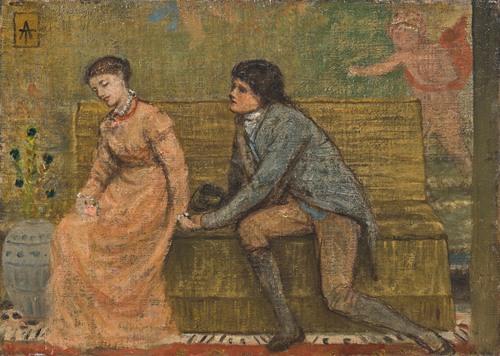



Thomas Armstrong was born on October 19, 1832 in Fallowfield, Manchester, the eldest son of Thomas Armstrong Sr., who was connected with the cotton industry, and his wife Sarah Evans. Armstrong received his early education at a private school in Tarvin in Cheshire. After leaving school Armstrong worked for Openshaws, a business house in Manchester, whose owners were friends of his family. In his leisure time Thomas attended art classes in Manchester and in 1852 exhibited two paintings at the Royal Manchester Institution. After he had worked for Openshaws for a year his employer realised that Armstrong was not cut out to be a successful businessman. He suggested Armstrong follow his desire to become an artist and gave him money to start in that direction.
His former employer also suggested he study art in Paris art and, despite initial opposition from his family, his artistic training began there in 1853. He initially studied in the atelier of Gabriel Navier, where he became a pupil of Ary Scheffer. In the evenings Armstrong studied at Suisse's Academy. In 1854 he spent some time in the artists' colony at Barbizon where he met Jean Francois Millet. Armstrong went to Antwerp to study in June 1855 where he worked in the Royal Academy of Fine Arts under Jozef van Lerius for a few months before returning home to Manchester. He returned to Paris in 1856 to train at Charles Gleyre's studio where his fellow pupils included George du Maurier, James Whistler, Val Prinsep, and Edward Poynter.
Armstrong lived in Algiers in 1858-59 with his uncle the Rev. William Evans. During Armstrong's time there he painted some Orientalist works. In 1859-1860 Armstrong spent time with du Maurier in Dusseldorf. He then returned to England in 1860, initially living in Manchester, but soon moved to London. Early on he lived in rooms in Great Russell Street, close to the du Mauriers and the Burne-Joneses. By 1865 Armstrong was living at 47 London Street, Fitzroy Square. In 1869 he moved to 121 Charlotte Street, Fitzroy Square where he lived for the next twelve years.
In his early years he was involved in numerous decorative projects with progressive architects like George Aitchison (architect of Leighton House) and W. E. Nesfield, sometimes in collaboration with his friend Randolph Caldecott whom he first met in 1870. In 1872 Armstrong paid the first of his numerous visits to Italy, his brother Frederick then living in Milan. On his first six-week tour he visited Milan, Verona, Padua, Venice. Ravenna, Bologna, Florence, Sienna and Spezia before returning to London via Paris and Boulogne. He exhibited in the Royal Academy in London from 1865 to 1877 and from 1888-91 at the Grosvenor Gallery. He also exhibited at the British Institution and the Dudley Gallery. In 1877 he became one of the founding members of the Society for the Protection of Ancient Buildings.

